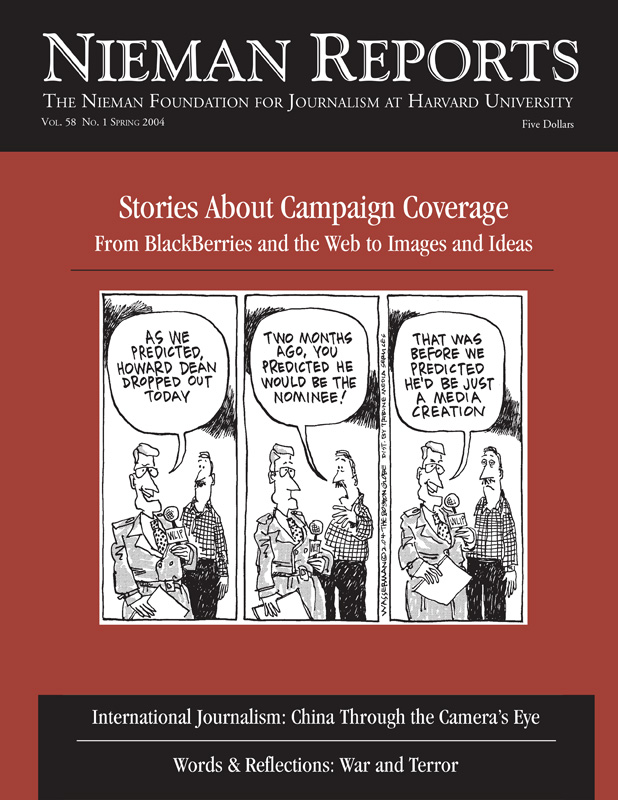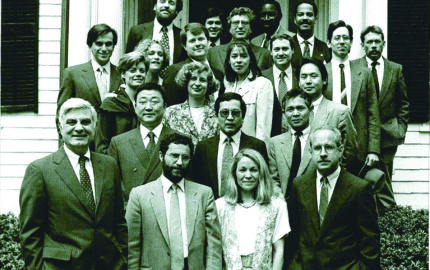On a bone-chilling January morning, the Nieman Fellows gathered around a warm fire at Lippmann House with Robert Coles, the professor who has taught at Harvard both in the fields of psychiatry and social reflection and who has spent a lifetime listening to children and women speak about their lives, absorbing their attitudes and experiences, and telling their stories in a remarkable collection of books.
Coles was talking about stories that formed the basis of insights he has contributed to our understanding of children’s lives. These stories stuck in his memory through a lifetime of teaching and had, by his own admission, complemented his work as a child psychiatrist. Truth is to be found in what people experience and tell, he explained, rather than in the therapist’s interpretation of what might be true.
In the introduction to his five-volume collection, “Children of Crisis,” he elaborates on the art of telling stories: “The stories develop their own energy; they take over—leaving me behind. I read them, afterwards, and hope I will forget that it was me, me, me—me going to visit patients, me glad when I could be of help to them, and me driven to write about them and proud that I could.”
To our ears that morning, Coles was evoking a value of storytelling that held particular resonance for our craft. We were listening to an eminent psychiatrist and teacher talk about his research in a manner that offered lessons in storytelling for journalists. He came to know children in their homes and schools and, as he wrote about them, he was able to convey their thoughts and feelings and describe the conditions of life that were challenging them. The beauty of a story, as he once wrote, is in its openness and how readers can take it in and put it to use in their own lives.
Coles’s method of working with children is not directly transferable to journalistic practice, of course. Reporters seek to establish trust essentially to assure a source that information shared is not going to be misused, rather than as a way to be a friend and confidant. Nor does Coles’s approach of engaging with his young patients require the detachment expected of journalists.
Along the way, Coles’s conversation with the Niemans shifted to journalism. At one point, he lamented the ways in which media—primarily television—belittles the telling of human experience. Later, one of the fellows asked what kind of journalism he found effective. “Journalism that tells stories,” he replied. He marveled at the transformation of The New York Times in this regard. “The Times used to be just the paper of record” and now it is a place where readers also find “wonderful stories.”
There were nods around the room, for without using the word, Coles was emphasizing the power of narrative, drawing a connection between the stories he hears and writes and uses in his teaching and stories in our newspapers. He was describing the transformative power of stories, reminding us how stories about others can lead us to discoveries about ourselves and how they absorb the reader into the emotions of the characters. At that moment, Coles brought together the relationship between his stories as a teacher and writer and the stories we publish that inform and enlighten readers. He was applauding a growing trend in journalism, of which the Times has become a leader, to sustain reader interest and deepen coverage by telling stories in a style that is different from the way they are usually told in newspapers.
This is the time of year when journalists assess one another’s work in awarding prizes that bring recognition and stature to individuals and news organizations. The prizes are a refreshing reminder of excellence readers can find in the pages of newspapers and magazines. In describing their decisions, award juries often write about effective storytelling standing alongside exhaustive reporting. Such was the case as the American Society of Newspaper Editors recognized Anthony Shadid of The Wasington Post for deadline reporting for his coverage of the war in Iraq: “Shadid delivered from Iraq with an enormous descriptive range and great lyrical power. He did it all from the base of great reporting stength.”
We take these signs as encouragement for the Nieman Foundation’s commitment to narrative journalism in which the rigor of journalism and the craft of storytelling come together. The intensive interest in the annual Nieman Conference on Narrative Journalism, where last December on a weekend of deep snowfall 1,000 journalists and writers gathered in Cambridge, affirms that what Coles was on to all along is now becoming properly and increasingly embedded in daily journalism.
At a Nieman narrative conference a few years ago, Jacqui Banaszynski of The Seattle Times was talking about why we need stories. She began by quoting Mary Lawrence, a journalism teacher at the University of Missouri: “We’re fooling ourselves if we think we communicate primarily by bursts of information. We live for stories—whether they’re movies or TV shows or plays or poems or even newspaper pieces. We want stories told to us over and over. … They comfort us, they arouse us, they excite us and educate us, and when they touch our hearts we embrace them and keep them with us.”



